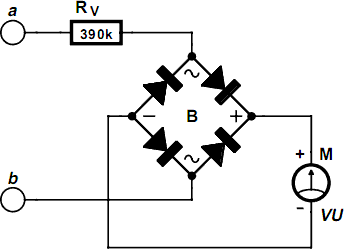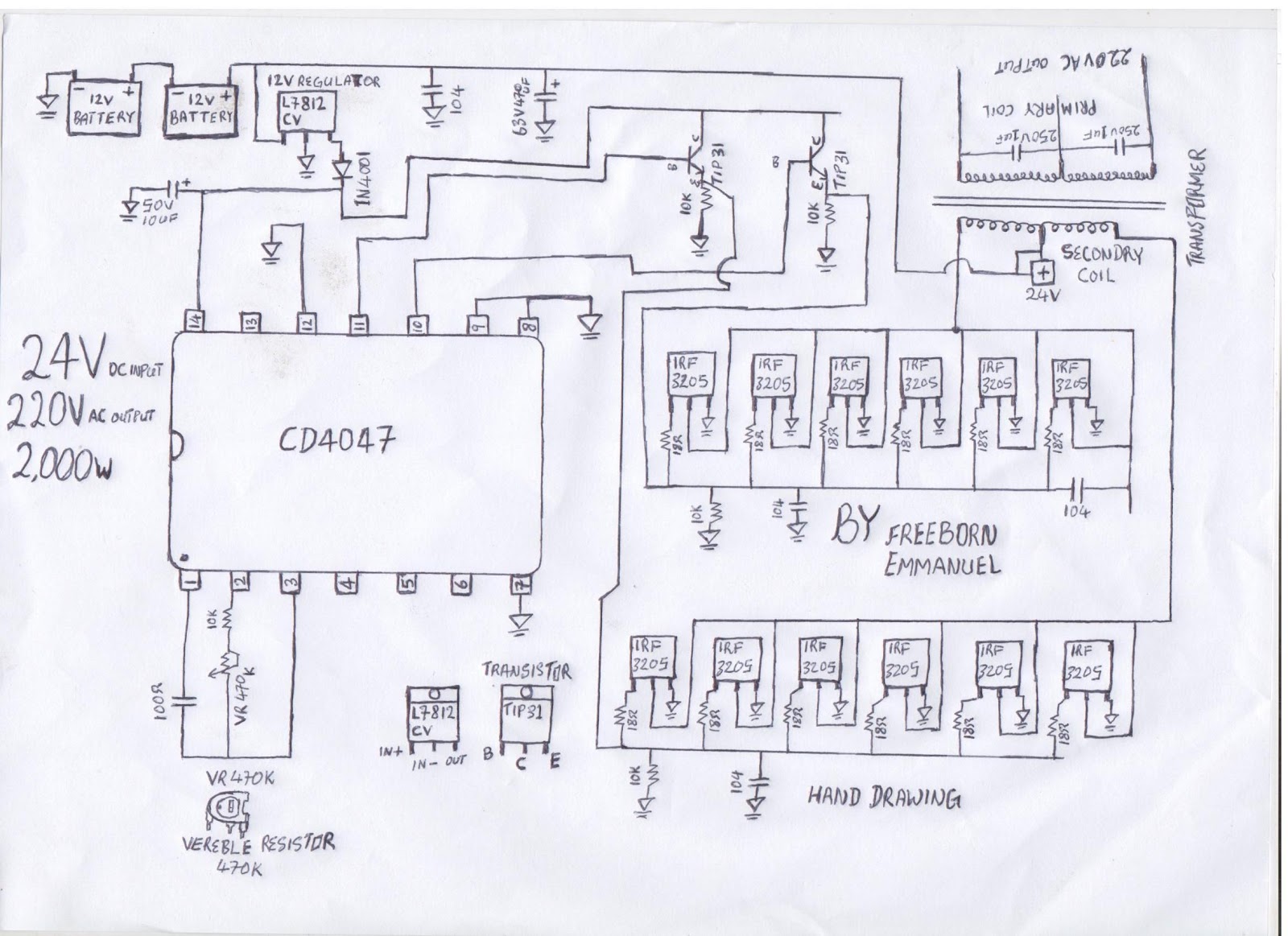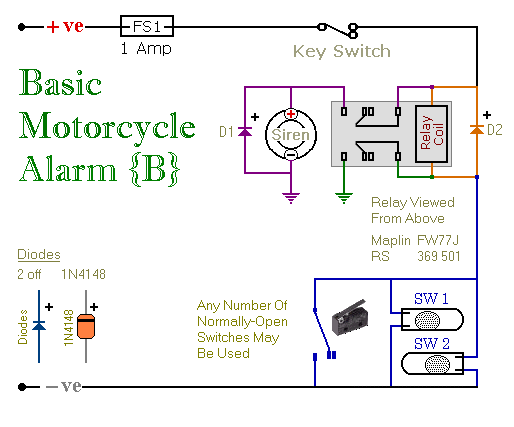
Telephone Line Indicator Circuit

Using an old moving coil instrument, it is easy to create a simple voltmeter that indicates the status of a telephone line at a glance. The circuit's high input impedance allows it to be permanently connected to the line, drawing only a minimal amount of current. The schematic illustrates that the circuit comprises a series resistor, a bridge rectifier, and a moving coil meter. The resistor value is determined by the sensitivity of the moving coil meter. In prototypes, old VU meters requiring 250 µA for full-scale deflection were used, with an optimal resistor value of 390 kΩ. For a 100 µA instrument, the resistor value should be increased to approximately 680 kΩ. The initial criterion for selecting the resistor value is that when the telephone is idle, the meter should deflect about two-thirds of the full scale. The meter deflection indicates three states of the telephone line: 1. A very small deflection indicates the line is in use (voltage 5 to 12 V). 2. A two-thirds deflection indicates the line is not in use (typically 48 V). 3. Full-scale deflection indicates a ring signal (60 to 90 V AC). Due to the high idle and ring voltages, which can be dangerous, it is advised that the circuit be designed to minimize hazards when touched.
The circuit design for the voltmeter to monitor telephone line status includes essential components that ensure accurate readings while maintaining user safety. The moving coil meter serves as the primary indicator, displaying the voltage levels corresponding to different states of the telephone line. The bridge rectifier is crucial for converting the AC voltage from the telephone line into a DC voltage suitable for the moving coil meter.
The series resistor plays a vital role in determining the current flowing through the meter, which directly impacts the deflection observed. The selection of this resistor is based on the meter's full-scale sensitivity. For instance, using a 250 µA VU meter, a resistor value of 390 kΩ allows for optimal performance, ensuring that the meter indicates approximately two-thirds deflection when the line is idle. Conversely, for a more sensitive 100 µA meter, a higher resistance of around 680 kΩ is required to achieve similar deflection characteristics.
The operational states of the telephone line are defined by specific voltage ranges that correspond to the deflection of the meter. A small deflection indicates that the line is active, with a voltage typically ranging from 5 to 12 V, reflecting current usage. A two-thirds deflection signifies that the line is idle, with a nominal voltage of around 48 V, while full-scale deflection indicates the presence of a ringing signal, which can range from 60 to 90 V AC.
Safety considerations are paramount, especially given the high voltages involved. The design should incorporate features to ensure that users can safely interact with the circuit without risk of electric shock. This can include utilizing insulated components, ensuring proper casing, and implementing design techniques that minimize exposure to high voltage areas. Overall, the circuit presents a practical solution for monitoring telephone line status while prioritizing user safety and ease of use.With the aid of an (old) moving coil instrument it is very little effort to make a simple voltmeter that, at a glance, indicates the status of a telephone line. Because the input impedance of this circuit is very high, there is no problem in having it permanently connected to the line, since it only draws a tiny amount of current.
The schematic sh ows that the circuit consists of no more than a series resistor, a bridge rectifier and a moving coil meter. The value of the resistor depends on the sensitivity of the moving coil meter. In his prototypes, the author used old VU meters that require 250 µA for full-scale deflection. A resistor value of 390 k appeared to be optimal for these meters. For a 100- µA-instrument, this resistor value will have to be increased to about 680 k. The starting point, when selecting a resistor value is that when the telephone is not in use, the meter should de ¬‚ect about 2/3rd of full scale.
The amount of meter deflection indicates the three different states of the telephone line: 1. The deflection is very small: the line is in use (voltage 5 to 12 V). 2. The deflection is 2/3rd of full scale: the line is not in use (voltage typically 48 V). 3. Full-scale deflection: ring signal (60 to 90 V AC). Because the idle voltage and certainly the ring voltage are high enough to be dangerous, it is recommended that the circuit is constructed in such a way that it presents no hazard when touched. 🔗 External reference
The circuit design for the voltmeter to monitor telephone line status includes essential components that ensure accurate readings while maintaining user safety. The moving coil meter serves as the primary indicator, displaying the voltage levels corresponding to different states of the telephone line. The bridge rectifier is crucial for converting the AC voltage from the telephone line into a DC voltage suitable for the moving coil meter.
The series resistor plays a vital role in determining the current flowing through the meter, which directly impacts the deflection observed. The selection of this resistor is based on the meter's full-scale sensitivity. For instance, using a 250 µA VU meter, a resistor value of 390 kΩ allows for optimal performance, ensuring that the meter indicates approximately two-thirds deflection when the line is idle. Conversely, for a more sensitive 100 µA meter, a higher resistance of around 680 kΩ is required to achieve similar deflection characteristics.
The operational states of the telephone line are defined by specific voltage ranges that correspond to the deflection of the meter. A small deflection indicates that the line is active, with a voltage typically ranging from 5 to 12 V, reflecting current usage. A two-thirds deflection signifies that the line is idle, with a nominal voltage of around 48 V, while full-scale deflection indicates the presence of a ringing signal, which can range from 60 to 90 V AC.
Safety considerations are paramount, especially given the high voltages involved. The design should incorporate features to ensure that users can safely interact with the circuit without risk of electric shock. This can include utilizing insulated components, ensuring proper casing, and implementing design techniques that minimize exposure to high voltage areas. Overall, the circuit presents a practical solution for monitoring telephone line status while prioritizing user safety and ease of use.With the aid of an (old) moving coil instrument it is very little effort to make a simple voltmeter that, at a glance, indicates the status of a telephone line. Because the input impedance of this circuit is very high, there is no problem in having it permanently connected to the line, since it only draws a tiny amount of current.
The schematic sh ows that the circuit consists of no more than a series resistor, a bridge rectifier and a moving coil meter. The value of the resistor depends on the sensitivity of the moving coil meter. In his prototypes, the author used old VU meters that require 250 µA for full-scale deflection. A resistor value of 390 k appeared to be optimal for these meters. For a 100- µA-instrument, this resistor value will have to be increased to about 680 k. The starting point, when selecting a resistor value is that when the telephone is not in use, the meter should de ¬‚ect about 2/3rd of full scale.
The amount of meter deflection indicates the three different states of the telephone line: 1. The deflection is very small: the line is in use (voltage 5 to 12 V). 2. The deflection is 2/3rd of full scale: the line is not in use (voltage typically 48 V). 3. Full-scale deflection: ring signal (60 to 90 V AC). Because the idle voltage and certainly the ring voltage are high enough to be dangerous, it is recommended that the circuit is constructed in such a way that it presents no hazard when touched. 🔗 External reference





